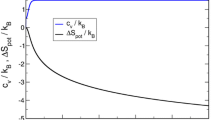Abstract
The theory of the spontaneous polarization of the adsorbed monolayer of polar molecules is developed using the collective variables method. The total potential of the system is represented as the sum of the one-body and two-body interaction potentials. The one-body potential depends on the orientation of the molecular dipoles in the external electric field and on the interactions between the molecules and the substrate. The two-body potential consists of the sum of intermolecular potentials which can be separated into the “short-range” part describing the orientation-independent interaction at distances, and the long-range part dependent on both the coordinates and the orientations of the interacting species. The variation of the configurational Helmholtz free energy of the system related to the long-range orientational interactions is shown to consist of three terms describing different modes of interactions of density fluctuations: (a) neglect of particle's density fluctuation or self-consistent mean field approximation (SCMF), (b) harmonic oscillations of the particle's density-the random phases approximation (RPA), and (c) various unharmonic interactions of the fluctuation waves. In the SCMF approximation using the assumption of the multiplicative separation of the high-order distribution function the singlet distribution function is calculated and the polarization vector of the adsorbed monolayer is determined. The corrections to the singlet distribution function arising from the terms (b) and (c) of the free energy are calculated. It is shown that the spontaneous polarization of the adsorbed monolayer of polar molecules may be regarded as the first-order phase transition.
Similar content being viewed by others
References
B. V. Derjaguin and Yu. V. Shulepov,Surf. Sci. 81:149 (1979).
D. N. Zubarev,Dokl. Acad. Nauk USSR 95:757 (1954).
I. R. Yukhnovsky and M. F. Holovko,Statistical Theory of the Classical Equilibrium Systems (Naukova Dumka, Kiev, 1980).
J. L. Lebowitz, G. Stell, and S. Baer,J. Math. Phys. 6:1282 (1965).
G. Stell, inPhase Transitions and Critical Phenomena, Vol. 5b, C. Domb and M. S. Green, eds. (Academic Press, New York, 1975), p. 205.
P. C. Hemmer and J. L. Lebowitz, inPhase Transition and Critical Phenomena, Vol. 5b, C. Domb and M. S. Green, eds. (Academic Press, New York, 1975), p. 107.
J. S. Høye and G. Stell,J. Chem. Phys. 61:562 (1974).
J. S. Høye, J. L. Lebowitz, and G. Stell,J. Chem. Phys. 61:3253 (1974).
J. S. Høye and G. Stell,J. Chem. Phys. 72:1597 (1980).
G. Stell, G. N. Patey, and J. S. Høye,Adv. Chem. Phys. 48:183 (1981).
T. F. Meister and B. U. Felderhof,Physica 102A:145 (1980).
F. P. Buff and N. S. Goel,J. Chem. Phys. 56:2405 (1972).
P. C. Das and J. I. Gersten (1982).J. Chem. Phys. 76:3177 (1982).
R. Kubo,J. Phys. Soc. Japan 17:1100 (1962).
H. C. Andersen and D. Chandler,J. Chem. Phys. 55:1447 (1971).
H. C. Andersen and D. Chandler,J. Chem. Phys. 57:1918 (1972).
I. S. Gradstein and I. M. Rishik,Tables of the Integrals, Sums, Series, and Products (Nauka, Moskow, 1971), p. 120.
B. P. Demidovich and I. A. Maron,The Basis of Computational Mathematics (Nauka, Moskow, 1970), p. 120.
Kerson Huang,Statistical Mechanics (Mir, Moskow, 1966).
N. A. Tolstoj, A. A. Spartakov, and A. A. Trusov, inResearch in the Field of Surface Forces (Nauka, Moskow, 1967), p. 67 [Consultants Bureau, New York, 1971), p. 49].
V. V. Vojtilov, N. A. Tolstoj, and A. A. Trusov,Kolloid J. 42:1051 (1980).
Author information
Authors and Affiliations
Rights and permissions
About this article
Cite this article
Yukhnovsky, I.R., Shulepov, Y.V. Theory of the spontaneous polarization of the adsorbed monolayer of polar molecules. The collective variables method. J Stat Phys 38, 541–572 (1985). https://doi.org/10.1007/BF01010477
Received:
Revised:
Issue Date:
DOI: https://doi.org/10.1007/BF01010477




